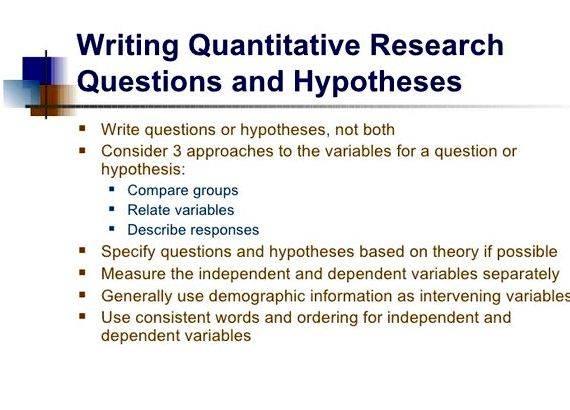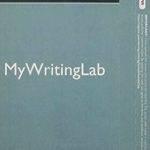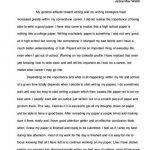Quantitative research questions:
What do I have to think about?
If your dissertation is attempting to answer one or more quantitative research questions, there are a number of factors you need to think about before getting started. These factors include: (a) the types of quantitative research questions you are trying to answer; (b) the variables you want to measure, manipulate and/or control; (c) how you should structure your research questions; and (d) whether you should use research questions as opposed to research hypotheses. Understanding these factors is important before reading some of the other articles on quantitative research questions on this website, which go into each factor in more detail.
This article addresses the following questions, which are an important starting point to understand what is required when creating quantitative research questions:
What type of quantitative research question are you trying to answer?
Understanding the types of quantitative research question (i.e. descriptive. comparative and/or relationship ) you want to answer is your first task when using a quantitative research design. This section of the article briefly discusses the difference between these three types of quantitative research question.
What variables are you trying to measure, manipulate and/or control?
Having established the quantitative research questions you want to answer, it is important to identify the variables that you intend to measure. manipulate and/or control. This section of the article briefly discusses the different types of variables (i.e. independent and dependent ; categorical or continuous variables) you may choose to examine.
How should you structure your quantitative research question?
Having identified the variables to include in your research, you will need to structure your research questions in a way that the reader can clearly understand what you are trying to achieve. How you structure these research questions will depend on the type of research questions you have and the variables you are examining. This section of the article briefly discusses the main things to think about when structuring your research questions.
Should you use quantitative research questions or research hypotheses?
Quantitative research questions and research hypotheses are designed to accomplish different tasks. Sometimes dissertations should include both although this is not always the case. This section of the article briefly discusses the difference between quantitative research questions and research hypotheses and when to use both (as opposed to just one or the other).
Each of these questions is addressed in more detail in the sections that follow. If you are interested in a particular section, click on the links below:
What type of quantitative research question are you trying to answer?
Dissertations that are based on a quantitative research design attempt to answer at least one quantitative research question. However, there is more than one type of quantitative research question that you can attempt to answer [see the article, Types of quantitative research question. for a more comprehensive look at these types of quantitative research question].

Quantitative research questions are based on one of three basic approaches to examining the variables you are interested in. These three basic approaches involve either describing. comparing or relating .
Let’s imagine we are interested in examining Facebook usage amongst university students in the United States .
We could describe factors relating to the make-up of these Facebook users, quantifying how many (or what proportion) of these university students were male or female, or what their average age was. We could describe factors relating to their behaviour, such as how frequently they used Facebook each week or the reasons why they joined Facebook in the first place (e.g. to connect with friends, to store all their photos in one place, etc.). Potential descriptive quantitative research questions would be:
How often do students use Facebook?
What are the reasons that encourage students to join Facebook?
We could compare some of these factors (i.e. those factors that we had just described). For example, we could compare how frequently the students used Facebook each week, looking for differences between male and female students.
We could relate one or more of these factors (e.g. age) to other factors we had examined (e.g. how frequently students used Facebook each week) to find out if there were any associations or relationships between them. For example, we could relate age to how frequently the students used Facebook each week. This could help us discover if there was an association or relationship between these variables (i.e. age and weekly Facebook usage), and if so, tell us something about this association or relationship (e.g. its strength, direction, and/or statistical significance).
These three approaches to examining the variables you are interested in (i.e. describing. comparing and relating ) are addressed by setting descriptive. comparative or relationship-based research questions. Understanding the difference between these three types of quantitative research question is important for a number of reasons. For example:
The way that you structure your research questions; that is, the way that you write out your research questions will vary depending on the type of research question you are trying to answer [see the article: How to structure quantitative research questions ].
The type of research questions you are trying to answer influences the type of quantitative research design you use.
To learn more about these three types of quantitative research question (i.e. descriptive, comparative and relationship-based research questions) in more detail, see the article: Types of quantitative research question .
What variables are you trying to measure, manipulate and/or control?
Having established the quantitative research questions you want to answer, it is important to identify the variables that you intend to measure. manipulate and/or control. This is a critical component of experimental. quasi-experimental and relationship-based research designs [see the section on Quantitative research designs to learn more]:
In order to identify the variables that you intend to measure, manipulate and/or control, you also need to be able to recognise the different types of variables (i.e. independent and dependent ; categorical or continuous variables) you intend to study. Whilst we describe these types of variables in detail in the article, Types of variables. you need to be aware of the differences between independent and dependent variables, and categorical and continuous variables.
Categorical and continuous variables
There are two groups of variables that you need to know about: categorical variables and continuous variables. We use the word groups of variables because both categorical and continuous variables include additional types of variables. Categorical variables. also known as qualitative (or discrete ) variables. can be further classified a being nominal. dichotomous or ordinal. On the other hand, continuous variables. also known as quantitative variables. can be further classified a being either interval or ratio. For example, the variable gender (male or female) in the Facebook example is a dichotomous variable. When performing quantitative analysis on the data you collect during the dissertation process, you need to understand what type of categorical or continuous variables you are measuring.
Independent and dependent variables
A variable is not only something that we measure. but also something that we can manipulate and something we can control for. For this reason, we distinguish between independent and dependent variables. An independent variable. sometimes called an experimental or predictor variable. is a variable that is being manipulated in an experiment in order to observe the effect on a dependent variable. sometimes called an outcome variable. Understanding which of the variables you are studying are the independent. dependent and control variables is necessary in order to know how to structure and write up your research questions.
At this stage, you should now know:
What types of quantitative research question (i.e. descriptive, comparative or relationship-based research questions) you are trying to answer.
What variables you are interested in and which variables you are trying to measure, manipulate and/or control.
Armed with this knowledge, you now need to think about how to structure your quantitative research questions; that is, how you can write out your research questions in a way that the reader can clearly understand what you are trying to achieve.
How should you structure your quantitative research question?
There is no “one best way” to structure a quantitative research question. However, we recommend an approach that is based on three steps :
Choose the type of quantitative research question you are trying to create
The type of quantitative research question that you use in your dissertation (i.e. descriptive, comparative and/or relationship) needs to be reflected in the way that you write out the research question; that is, the word choice and phrasing that you use when constructing a research question tells the reader whether it is a descriptive, comparative or relationship-based research question. Therefore, in order to know how to structure your quantitative research question, you need to start by selecting the type of quantitative research question you are trying to create: descriptive, comparative and/or relationship.
Set out the first words that start the research question
Quantitative research questions tend to start with words like “What are”. “How do”. “Does”. “How often”. amongst others. Which words you start with will depend on the type of quantitative research question you are trying to create (i.e. descriptive, comparative and/or relationship) and the goal of the question.
Determine the correct order for the variables you are investigating
The type of quantitative research question you are trying to create (i.e. descriptive, comparative and/or relationship) and the choice of variables you are trying to measure, manipulate and/or control (i.e. independent, dependent and/or control variables) influence how you structure the research question. As a general rule, we suggest that independent variables are set out first, followed by dependent variables, and then control variables (if there are any).
In the section, How to structure quantitative research questions. we discuss these three steps in more detail, providing examples along the way.
Should you use quantitative research questions or research hypotheses?
Quantitative research questions and research hypotheses are designed to accomplish different tasks:
Explain the purpose of the research. In other words, what issue or problem is the research trying answer? In terms of quantitative research questions, the type of research question (i.e. descriptive, comparative and/or relationship) helps to explain the purpose of the research.
Explain the predictions being made (or otherwise) by the researcher based on specific hypothesis statements. These hypothesis statements set out what problem or issue the research is trying to answer, as well as their directionality, which help to explain the predictions being made (or otherwise) by the researcher.
Sometimes dissertations should include both research questions and research hypotheses although this is not always the case:
If you feel like the research questions are no more than a repetition of the research hypotheses, it is often better to include only one or the other (i.e. only research hypotheses or only research questions). As a general rule, we would suggest using hypotheses rather than research questions in these cases.
If the research hypotheses build on the research questions, especially if there are multiple research hypotheses used to address a single research question, we would recommend using research questions and research hypotheses.
If you choose to use research hypotheses, whether instead of research questions or in addition to them, these should be written differently to research questions. However, if you are using quantitative research questions, we have articles that can help you learn about the different types of quantitative research questions and how to structure quantitative research questions .
Before you begin writing a grant proposal, take some time to map out your research strategy. A good first step is to formulate a research question.
A Research Question is a statement that identifies the phenomenon to be studied. For example, “What resources are helpful to new and minority drug abuse researchers?”
To develop a strong research question from your ideas, you should ask yourself these things:
- Do I know the field and its literature well?
- What are the important research questions in my field?
- What areas need further exploration?
- Could my study fill a gap? Lead to greater understanding?
- Has a great deal of research already been conducted in this topic area?
- Has this study been done before? If so, is there room for improvement?
- Is the timing right for this question to be answered? Is it a hot topic, or is it becoming obsolete?
- Would funding sources be interested?
- If you are proposing a service program, is the target community interested?
- Most importantly, will my study have a significant impact on the field?
A strong research idea should pass the “so what” test. Think about the potential impact of the research you are proposing. What is the benefit of answering your research question? Who will it help (and how)? If you cannot make a definitive statement about the purpose of your research, it is unlikely to be funded.
A research focus should be narrow, not broad-based. For example, “What can be done to prevent substance abuse?” is too large a question to answer. It would be better to begin with a more focused question such as“What is the relationship between specific early childhood experiences and subsequent substance-abusing behaviors?”
A well-thought-out and focused research question leads directly into your hypotheses. What predictions would you make about the phenomenon you are examining? This will be the foundation of your application.
Hypotheses are more specific predictions about the nature and direction of the relationship between two variables. For example, “Those researchers who utilize an online grant writing tutorial will have higher priority scores on their next grant application than those who do not.”
- Give insight into a research question;
- Are testable and measurable by the proposed experiments;
- Spring logically from the experience of the staff;
Normally, no more than three primary hypotheses should be proposed for a research study. A proposal that is hypothesis-driven is more likely to be funded than a “fishing expedition” or a primarily descriptive study.
- Provide a rationale for your hypotheses�where did they come from, and why are they strong?
- Provide alternative possibilities for the hypotheses that could be tested�why did you choose the ones you did over others?
If you have good hypotheses, they will lead into your Specific Aims. Specific aims are the steps you are going to take to test your hypotheses and what you want to accomplish in the course of the grant period. Make sure:
- Your objectives are measurable and highly focused;
- Each hypothesis is matched with a specific aim.
- The aims are feasible, given the time and money you are requesting in the grant.
An example of a specific aim would be “Conduct a rigorous empirical evaluation of the online grant writing tutorial, comparing outcome and process measures from two groups�those with exposure to the tutorial and those without.”
- Why are you doing this research?
- What are the long-term implications?
- What will happen after the grant?
- What other avenues are open to explore?
- What is the ultimate application or use of the research?
These questions all relate to the long-term goal of your research, which should be an important undercurrent of the proposal. Again, they should be a logical extension of the research question, hypotheses, and specific aims.
It is also helpful to have a long-term plan for your own career development. Where would you like to see your career go in the next 5 years? How does the research you are proposing relate to that plan?
Once you've thought through the key elements of your research questions, hypotheses, specific aims, and research design, you have the ingredients for a concept paper. This is an important tool to help you to organize your thoughts, as well as to promote, disseminate, or get feedback on your ideas. A concept paper is a succinct description of your research plan (3 to 5 pages) and can be particularly useful when trying to recruit collaborators or solicit letters of support. It is also useful to send a copy of the concept paper to a NIDA Program Official in the branch or office that covers your topic area.





 My writing desk schreibtisch modern
My writing desk schreibtisch modern My swordhand is singing summary writing
My swordhand is singing summary writing Myoril 4 mg composition writing
Myoril 4 mg composition writing Pearson my writing lab plus
Pearson my writing lab plus My attitude towards writing papers
My attitude towards writing papers






